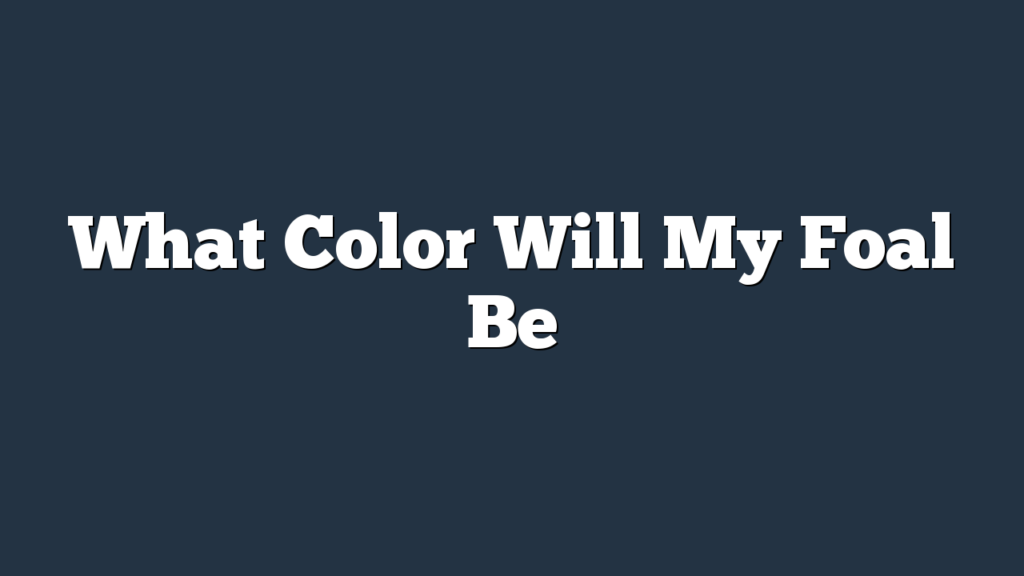Are you eagerly awaiting the arrival of your foal and wondering what color it will be? Understanding the basics of coat color genetics can help you predict the outcome.
By considering the parental coat colors, dominant and recessive genes, dilution genes, and other factors, you can get a glimpse into the possibilities.
Get ready to unravel the mystery and discover what color your foal will be.
Parental Coat Colors
To determine the potential coat color of your foal, you should consider the parental coat colors. Color genetics and coat color inheritance play a significant role in determining the coat color of a foal. The coat color of a horse is determined by the combination of genes inherited from its parents. These genes control the production of pigments responsible for the various coat colors and patterns.
In horses, the coat color inheritance is quite complex. There are several genes involved, each with multiple variations. The two main genes that determine the base coat color are the Extension gene and the Agouti gene. The Extension gene controls the production of either black or red pigment, while the Agouti gene determines if the black pigment will be evenly distributed or restricted to certain areas of the body.
Additionally, other genes can influence the coat color, such as the Cream gene, which lightens the base coat color, and the Gray gene, which causes the coat color to progressively turn gray over time.
Understanding Coat Color Genetics
To understand the coat color genetics of your foal, you need to grasp the complexities of how genes control pigmentation. The color of a horse’s coat is determined by a combination of genetic mutations and selective breeding. Genetic mutations are spontaneous changes in the DNA sequence that can alter the production of pigments in the hair. These mutations can result in unique coat colors or patterns that are not typically seen in the breed. Selective breeding, on the other hand, involves intentionally mating horses with specific coat colors to produce offspring with desired traits.
To give you a better understanding of coat color genetics, let’s take a look at a table that illustrates some of the most common coat colors and their corresponding genetic mechanisms:
| Coat Color | Genetic Mechanism |
|---|---|
| Bay | Agouti gene + Black gene |
| Chestnut | Red gene |
| Palomino | Cream gene |
| Grey | Grey gene |
Basic Coat Color Possibilities
You can determine the basic coat color possibilities of your foal by considering the coat colors of its parents. Coat color genetics play a significant role in determining the potential colors of your foal. By understanding the principles of coat color inheritance and the presence of dilution genes, you can make an educated guess about what color your foal might be.
When it comes to coat color genetics, there are two main types of genes: those that determine the base color and those that influence the dilution of that color. The base color genes can be either dominant or recessive, meaning they can be passed on to the offspring even if they aren’t visually expressed in the parents. On the other hand, dilution genes can affect the intensity or brightness of the base color, resulting in lighter or darker shades.
The Role of Dominant and Recessive Genes
How do dominant and recessive genes play a role in determining the coat color of your foal?
The role of alleles and genetic phenotypes can’t be understated when it comes to understanding the coat color of your foal. Let’s delve into the fascinating world of genetics and explore how these genes work together to create your foal’s unique coat color.
- Dominant Genes: A dominant gene is one that masks the effects of other genes. If a foal inherits a dominant gene for a specific coat color, it will express that color regardless of the presence of other genes. For example, if your foal inherits a dominant gene for a black coat color, it will display a black coat regardless of other genetic factors.
- Recessive Genes: Recessive genes, on the other hand, are genes that are masked by dominant genes. In order for a foal to express a recessive coat color, it must inherit two copies of the recessive gene. For example, if your foal inherits a recessive gene for a chestnut coat color from both parents, it will display a chestnut coat.
- Role of Alleles: Alleles are different forms of a gene that can occupy the same position on a chromosome. In the case of coat color, each parent contributes one allele to the foal. The combination of alleles determines the foal’s genetic makeup and, subsequently, its coat color.
Understanding the role of dominant and recessive genes, as well as the role of alleles, is essential in predicting the coat color of your foal. By considering the genetic phenotypes passed on from both parents, you can gain valuable insights into what color your foal will be.
Dilution Genes and Their Effects on Coat Color
Now let’s talk about dilution genes and their impact on coat color.
These genes play a crucial role in altering the intensity and shade of a horse’s coat.
By diluting the pigments present in the hair, dilution genes can create a range of stunning coat color variations, such as palomino, buckskin, and silver dapple.
Understanding these basics will help you predict and appreciate the potential coat colors of your foal.
Dilution Gene Basics
Understanding the effects of dilution genes on coat color can provide valuable insights into what color your foal may inherit. Dilution gene mutations are responsible for altering the intensity and hue of a horse’s coat color. By identifying these mutations through genetic testing for coat color, breeders can predict the potential color outcomes for their foals.
Here are three key points to consider:
- Dilution genes can lighten the base coat color, resulting in shades such as palomino or buckskin.
- Some dilution genes affect the distribution of pigment, leading to patterns like roan or appaloosa.
- Dilution genes can also impact the color of the mane, tail, and points of a horse, creating variations like silver dapple or champagne.
Coat Color Variations
To determine the potential coat color variations of your foal, consider the effects of dilution genes on coat color. Coat color genetics is a complex subject, but understanding how dilution genes work can give you insight into the possible outcomes.
Dilution genes can lighten or darken the coat color of a horse by affecting the distribution and intensity of pigments. There are several types of dilution genes, each with its own unique effect on coat color.
For example, the cream gene can dilute a horse’s coat color, resulting in palomino, buckskin, or cremello offspring. The dun gene, on the other hand, can create a range of dilution patterns, including grullo and dunskin.
Factors Influencing Color Expression
When it comes to predicting the color of your foal, there are two main factors that influence color expression: genetic inheritance patterns and environmental influences.
Genetic inheritance patterns determine which genes are passed down from the parents and can play a significant role in determining the color of the foal.
However, environmental influences such as diet, sunlight exposure, and even temperature can also impact the expression of certain coat colors.
Genetic Inheritance Patterns
By understanding the compound prepositions that influence the genetic inheritance patterns, you can predict the color expression of your foal. Genetic mutations play a significant role in determining the color of your foal. These mutations can alter the production or distribution of pigments, resulting in a wide range of colors.
Breeding strategies also come into play when predicting color expression. By carefully selecting the parent horses with desired color traits, you can increase the chances of your foal inheriting those traits. Additionally, understanding dominant and recessive genes is crucial in determining color inheritance.
It’s important to note that while genetic inheritance patterns can provide a general idea of your foal’s color, there’s always a level of unpredictability due to the complex nature of genetics.
Environmental Influences
Understanding the compound prepositions that influence genetic inheritance patterns, you can now explore the environmental influences that play a role in determining the color expression of your foal. One important environmental factor to consider is seasonal changes in coat color.
Just like humans, horses can experience changes in their coat color throughout the year. For example, a foal may be born with a darker coat during the winter months and then develop a lighter coat during the summer. This is known as seasonal color variation and is influenced by factors such as temperature and sunlight exposure.
Another significant environmental influence on coat color development is nutrition. The nutrients that a mare consumes during pregnancy can impact the color expression of her foal’s coat. For instance, a diet deficient in certain vitamins and minerals may result in a dull or faded coat color. On the other hand, a well-balanced diet with the right amount of essential nutrients can promote a vibrant and healthy coat.
Therefore, it’s crucial to provide your mare with a proper nutrition plan to ensure optimal coat color development in her foal.
Uncommon Coat Colors and Patterns
You can explore uncommon coat colors and patterns in your foal. While most foals are born with common coat colors, such as bay, chestnut, or black, there are some rare and fascinating variations that can appear due to unusual markings or genetic mutations. These uncommon coat colors and patterns can make your foal truly unique and stand out from the crowd.
Here are three intriguing examples to pique your interest:
- Sabino: This coat pattern is characterized by white markings on the face, legs, and belly. It can range from minimal white accents to a high degree of white, giving the horse a stunning and eye-catching appearance.
- Dun: This coat color is caused by a dilution gene that affects the horse’s base color, resulting in a pale or sandy hue. Dun horses often have primitive markings, such as a dorsal stripe down their back or zebra-like striping on their legs, adding an exotic touch to their overall look.
- Roan: Roan horses have a mixture of colored and white hairs throughout their coat, creating a beautiful speckled or mottled appearance. The degree of roaning can vary, from a few scattered white hairs to almost completely white, giving the horse a striking and ethereal appearance.
Exploring these uncommon coat colors and patterns can be an exciting adventure as you anticipate the arrival of your foal. Whether it’s the result of unusual markings or genetic mutations, your foal’s coat will undoubtedly be a visual delight.
Predicting the Foal’s Coat Color
How can you determine the coat color of your foal? Predicting the foal’s coat color is an exciting part of horse breeding. Understanding genetic inheritance patterns is crucial in determining what color your foal is likely to be. Coat color in horses is influenced by a complex interaction of genes. There are several coat color genes that determine the color and pattern of a horse’s coat. These genes can be passed down from the parents to the foal in predictable ways.
One of the most well-known genetic inheritance patterns in horse coat color is the basic coat color inheritance. This pattern involves the interaction of two main genes: the extension gene and the agouti gene. The extension gene determines whether a horse will have a black or red base coat color. The agouti gene, on the other hand, controls the distribution of black pigment in the coat. By understanding the inheritance of these genes, you can make predictions about the foal’s coat color.
It’s important to note that predicting foal coat color isn’t an exact science. There are many factors that can influence the outcome, such as the presence of modifier genes and random mutations. However, by understanding the basic genetic inheritance patterns, you can have a better idea of what color your foal is likely to be.
Frequently Asked Questions
How Can I Determine the Specific Shade of Color My Foal Will Have?
To determine the specific shade of color your foal will have, consider the determining genetic factors and environmental influences. These factors play a role in determining the unique coloration of your foal.
Are There Any Genetic Tests Available to Accurately Predict the Foal’s Coat Color?
Yes, there are genetic tests available to accurately predict your foal’s coat color. These tests can provide you with precise information about the specific shades and patterns your foal may inherit.
Can the Foal’s Coat Color Change as It Grows Older?
Yes, the foal’s coat color can change as it grows older. This is a normal process and not a cause for concern. The coat color does not affect the foal’s health.
Are There Any Specific Factors That Can Influence the Intensity of the Foal’s Coat Color?
Factors such as genetics, nutrition, and sunlight exposure can influence the intensity of your foal’s coat color. To enhance the coat color, ensure a balanced diet, provide adequate sunlight, and consider any breed-specific recommendations.
Is It Possible for a Foal to Have a Completely Different Coat Color Than Its Parents?
It’s possible for a foal to have a coat color completely different from its parents due to genetic mutations and variations. Environmental factors also play a role in the impact on foal coat color.
Conclusion
So, to answer your question about what color your foal will be, it all depends on the coat colors of the parents and the genetics involved.
Understanding coat color genetics, including dominant and recessive genes, dilution genes, and factors influencing color expression, can help predict the foal’s coat color.
However, keep in mind that there are also uncommon coat colors and patterns that could result.
Ultimately, the foal’s coat color will be a unique combination of its parents’ genetics.



